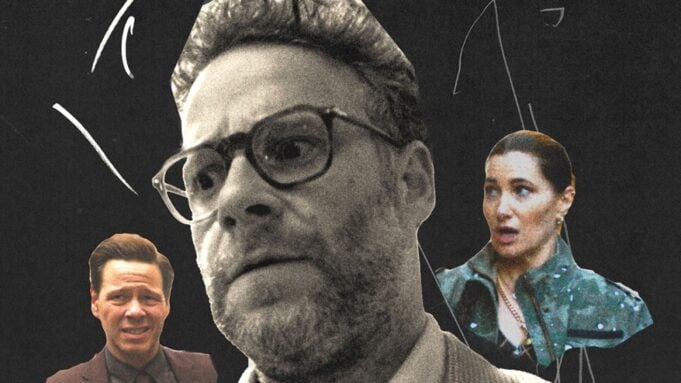In 2003, a few years after “Freaks and Geeks” and a few before “Superbad,” Seth Rogen sat in a Hollywood boardroom with his best friend and creative partner, Evan Goldberg. They were barely legal and new to Los Angeles, pitching a teen sex comedy set in ancient Rome called “Gen CCX.” Rogen doesn’t remember much about the script — it never got made. But something an executive said at the meeting stuck with him for more than two decades.
“I love movies, but now I have this fear that my job is to ruin them,” the unnamed exec told them. Twenty-two years later, that tragicomic koan would become the driving force behind “The Studio,” the scorching showbiz satire that stars Rogen as the newly appointed head of a film studio. Rogen recites that line in the first episode of the Apple TV+ comedy, out March 26.
“It was a very humanizing moment, as far as experiences with executives go,” says Rogen, now 42. It inspired him, one of Hollywood’s most prolific and bankable comedic artists, to cross enemy lines and embody a suit. Rest assured, though: Getting inside the heads of Hollywood honchos hasn’t made Rogen more sympathetic to them. “They could make good movies instead of bad movies, and a lot of them choose to make the bad ones because they think it’ll make their lives personally more secure,” he says.
That is the central conflict of “The Studio,” which finds Rogen’s character, Matt Remick, a starry-eyed cinephile, at the treacherous intersection of art and commerce. Co-starring Catherine O’Hara, Kathryn Hahn, Ike Barinholtz and Chase Sui Wonders as studio shot-callers, the series mixes the self-spoofing star power of “Entourage” with the comedic velocity of “Veep” and the zeitgeisty bite of “The Other Two.” It eviscerates the petty politics, eggshell egos and bottom-line mentality that stink up Hollywood.
Rogen is one of the industry’s most accomplished artists. He got his start as a teenage stand-up in Vancouver who caught the eye of Judd Apatow and then emerged from his shadow as a writer, actor, director and producer. He’s led comedy blockbusters from “Knocked Up” to “Pineapple Express” and made indies like “50/50” and “The Disaster Artist.” He’s also produced award-winning TV shows such as “The Boys” and “Pam & Tommy,” and lent his voice to Pumbaa and Donkey Kong in movies so globally recognized they need not be named.
Rogen was forged in the fire of Hollywood, and now he’s pouring gasoline on it. Inspired by his stint making movies at Sony, a relationship that imploded when his Kim Jong Un assassination comedy “The Interview” triggered one of the world’s most infamous cyberterrorist attacks, “The Studio” is born from Rogen’s decades of industry maneuvering. With cameos from A-listers like Zac Efron and Zoë Kravitz, and 10 episodes in which every scene is a single continuous take, it’s his most ambitious and impressive project yet.

Love Film & TV?
Get your daily dose of everything happening in music, film and TV in Australia and abroad.

Courtesy of Apple TV+
In the first few minutes of the series, Matt inherits his studio’s next slam dunk: a Kool-Aid movie. (“If Warner Bros. can make a billion fucking dollars off the plastic tits of a pussy-less doll, we should be able to make $2 billion off the legacy brand of Kool-Aid,” threatens the studio’s CEO, played by Bryan Cranston.)
Matt believes he can bridge the gap between branded fare and authored filmmaking, so when Martin Scorsese (playing himself) coincidentally pitches a movie about Jonestown (“Is that the massacre where everybody committed suicide by drinking Kool-Aid?”), the wheels start turning. But can our protagonist reverse-engineer a Kool-Aid movie from the greatest living director, making him think it was his idea in the first place? Spoiler alert: Of course not. And his spectacular, Larry David-esque failures propel the poisonous love letter to Hollywood that is “The Studio.”
To truly understand the entertainment industry, Rogen and Goldberg spent months picking the brains of the town’s most powerful gatekeepers: studio heads, marketing execs, agents and publicists. Some meetings were formal ones at their Los Angeles office — in 2011, Rogen and Goldberg founded the production company Point Grey Pictures — and others were casual chats over dinner.
“We asked a lot of them, ‘Do you view yourselves as artists?’ And you could tell a lot of them wanted to say yes. Some of them straight-up said yes,” Rogen says with that trademark chuckle. “That was a debate we were having throughout the whole time filming the show. What is art? Are they artists? It was very eye-opening to see how much creative ownership and pride they have over the movies that they’ve made.”
The studio executives in “The Studio” aren’t evil tycoons but rather movie nerds who want to be invited to celebrities’ parties and praised by the trades. Above all, they’re self-preservationists who cling to their jobs like a buoy. “The games that are constantly being played by people at the studios is ownership versus distance — how to navigate having ownership over something if it does well and distance from something if it does poorly,” Rogen says.
The characters surrounding Matt embody that gamesmanship. Barinholtz plays a coke-sniffing competitor who gets behind Matt when he loses out on the promotion. Wonders is Matt’s assistant turned creative exec, who gets a taste of power and, in one episode, threatens to sabotage a higher-up. Hahn’s attention-starved marketing wiz dresses and speaks like someone half her age in a desperate attempt to understand Gen Z. And O’Hara is Matt’s boss, who has been unceremoniously fired from the studio before strong-arming her way back in as a producer with an overall deal. In other words, she’s former Sony film chief Amy Pascal, who helped shepherd Rogen’s ascent to stardom via “Superbad,” “Pineapple Express” and “This Is the End.”
The show’s best jokes draw from Rogen’s own frustrations with Hollywood. The Kool-Aid kerfuffle, for one, was inspired by his experience co-writing and starring in the maligned comic adaptation “The Green Hornet.”
“When we made ‘Green Hornet,’ we learned how handcuffed we were by the things that had to be in it,” Rogen says. “At the time, we were a little naive as to how restrictive it actually was. Like, I had to work at a newspaper. I had to have a secretary named this. I had to have a guy named this who was my mean boss. None of those were ideas we would have arrived at on our own.”
A line in the first episode of “The Studio” about dreaded meetings with “the Jenga people” and Rubik’s Cube pokes fun at Hollywood’s obsession with milking movies out of just about any piece of IP. “Evan and I had a meeting for Monopoly like 15 years ago, and Ridley Scott was attached to direct it,” Rogen says. “It was a fancy Monopoly movie. That’s where part of the joke came from.” (That film obviously never happened, but that didn’t stop Margot Robbie and the producing team behind “Barbie” from rolling the dice on their own adaptation.)
The funniest (and, according to Rogen, most scarily accurate) episode focuses entirely on the casting process, with three white executives doing mental gymnastics over the racial demographics of the “Kool-Aid” voice cast. Is hiring a Black actor to voice the Kool-Aid Man “problematic”? If the Kool-Aid Man is Black, then does his wife also need to be Black? Should they just “‘Black Panther’ this shit” and make the entire cast Black? Or does the cast have to perfectly mirror the U.S. census?
Rogen attests that this type of “performative progressivism” is pervasive in Hollywood meetings, where he’s had to field questions like “What race is this alien?” “The thing that we’ve been caught up in over recent years is people genuinely not caring if they were doing something good, but caring as to whether they were being perceived as doing something good,” he says. It’s a theme that resonated with the cast too. Wonders, who is half-Chinese, recalls meeting with an agent earlier in her career who asked, wishfully, “You’re not Native American, are you?”
“That was a pendulum swing that Hollywood absolutely hopped on board,” Wonders says. “That white guilt sort of thing is correcting itself, and for the better.” Barinholtz agrees that Hollywood is starting to find a balance between filling an “imaginary quota” and making “every movie look like the 1958 Boston Celtics.”
But more than anything, “The Studio” is shaped by Rogen and Goldberg’s time at Sony Pictures. Their relationship with the studio fractured in 2014, when Sony suffered an unprecedented cyberattack before the release of “The Interview,” a comedy in which Rogen’s character gets wrapped up in a plot to kill the North Korean dictator. Hundreds of thousands of emails and other confidential material spilled onto the internet, and the hackers threatened to carry out terrorist attacks on cinemas showing the film, causing Sony to retreat and pull its wide release. The experience “traumatized” Rogen.
When asked whether any movie studio would make a provocative political satire like “The Interview” today, Rogen laughs. “Studios will make things that they think will make them money.”
That said, it’s safe to say that if Sony thought being compromised by a foreign entity was even a remote possibility, the studio would never have OK’d “The Interview” in the first place. “Nowhere in the conversation of that greenlight room was ‘What if North Korea retaliates with a massive act of cyberterrorism?’”
Crucial to the appeal of “The Studio” is that it looks stunning, and is shot unlike anything Rogen and Goldberg have ever made. There are ambitious set-pieces, tracking shots that follow vintage convertibles through winding hillsides and breathtaking vistas that will make even the most ardent haters of Los Angeles yearn for an Erewhon smoothie.
Plus, the show consists entirely of “oners,” long, uninterrupted takes shot with a single camera. Scenes run more than 10 minutes long with no cuts, a far cry from Rogen and Goldberg’s usual comedic playground, where two cameras get cross-coverage, there’s tons of improvisation and they “find it in the edit.”
“We liked the idea that this stripped all that from us and forced us to do something completely new,” Rogen says. He wanted “The Studio” to have a different visual language from the movies (both real and fake) shown in the series, and the challenging camera structure informed the “immersive and stressful” tone of the show.
“I’m not a great setup-punchline joke writer,” Rogen says. “I’m much better at structuring things with a propulsive build.”
The format was scary for both the directors and the performers. “The first few weeks of shooting, I honestly was having a hard time sleeping,” says Rogen. “I would come in every morning and be like, ‘Are we making a mistake?’” O’Hara describes it as “doing a play with no rehearsal,” where “there’s a look of fear and adrenaline pouring out of our eyeballs in every scene.”
“You don’t want to fluff a line because then the whole shot falls apart, and Seth and Evan are judging you,” Barinholtz says. “They’re smiling and laughing because they’re nice Canadian guys, but inside they want to kill you.”
In a sweet twist of irony, the series’ third episode harps on the loathsome concept of the studio note — and the oners allowed Rogen to dodge Apple’s feedback almost entirely. “Because of the way we shot it, essentially nothing could be done after the episode,” Rogen says. “Apple would give us notes, but the answer was always ‘We can’t do that.’ ‘Can you take out this line?’ ‘Nope.’ ‘Could you go from this line to this line?’ ‘Nope, we can’t do any of that.’”
With scripts including roles for Charlize Theron, Paul Dano and Netflix co-CEO Ted Sarandos — and dozens more — Apple’s main concern was that Rogen and Goldberg wouldn’t be able to secure all the cameos written into their first drafts.
“Apple was very skeptical and worried,” Rogen says. “They said early on, ‘You will never be able to get all the cameos you need to make this show.’ They could not have said it more definitively than that. That’s the moment we were like, ‘Oh, we have to prove these motherfuckers wrong.’”
Executives implored them to write versions of the episodes that didn’t rely on lassoing A-listers. Rogen and Goldberg refused. “This is how it has to be,” Rogen told them. “We’ll get these people.” (Besides Anthony Mackie taking on a part conceived for Leonardo DiCaprio, almost all of their dreams came true.)

Courtesy of Apple TV+
The most crucial guest star was Scorsese, whose arc in the first episode — and berating of Matt as a “talentless, spineless suit” — sets the tone for the rest of the season. Rogen sent Scorsese’s manager the script and was “shocked” the filmmaker said yes. Then came the dread of having to direct Scorsese. Rogen didn’t tell him in advance about the oners, and he was so nervous Scorsese would reject the one-camera setup that he hired a second camera crew to wait in the shadows.
“They were literally hiding in another hotel room just in case he was like, ‘You don’t have a second camera?’ I wanted to be like, ‘I do have a second camera actually!’” Rogen says. “I still don’t know how I would have creatively reconciled shooting those scenes differently than all the other scenes. But at that moment, it was more important that Martin Scorsese wasn’t mad at me.” Luckily, Scorsese was game, and Rogen describes his appearance as “a very unwarranted gift.”
Hollywood is ripe for satire, and everyone has their gripes about the state of things.
Wonders touts “Anora” as an “offbeat” phenomenon that swept the Oscars, and urges major studios to fund more $5 million movies. Barinholtz wants longer theatrical windows and more production in Los Angeles: “They need to open up all the tax credits. I’m sick of seeing all these other fucking states and countries steal production and crew members away from California.” And O’Hara laments that the internet has made Hollywood a “more nervous business than it was in the past.”
Hahn points out that social media has encouraged a torrent of opinions about projects that have yet to be released. “Shows are reviewed and bombed before anyone has seen them,” she says. “I felt it the most personally with ‘Agatha All Along,’ because sometimes the audience can have really strong opinions before they’ve seen it. It’s peanuts — it doesn’t mean anything.”
As for Rogen, he swears he’s not cynical about Hollywood, but says “there are ways for studios to be a little more open to risk without breaking the whole model.”
He believes the biggest issue facing moviemaking is actually something “The Studio” doesn’t directly address: the decimation of in-house development at studios. It’s an unsexy dilemma that nonetheless determines the types of movies that get made. With so few films developed internally, it’s agents who have filled the void, building projects at the packaging stage.
“That’s not how it should be. When I was young and we were making films like ‘Superbad,’ Sony bought the script, they hired a director, they believed in this movie,” Rogen says. “If that movie existed now, we would have to get the director and the entire cast attached beforehand.”
This structure disincentivizes risk, as talent shy away from projects that might not sell. “Everyone is weighing: If no one buys this, do I take a hit because I just attached myself to a script that no one wanted?”
“It ruined a huge part of the system,” Rogen adds, noting that several of his films in development over the past few years have “faced real challenges” because of it.
It’s part of Matt’s backstory that he bought a spec script and developed it into a $3 billion franchise for the studio, leading to his ascent. That type of long-term investment in a project from script to screen, by passionate executives with an ear to the ground, may no longer be viable in today’s landscape.
Still, like his character, Rogen remains optimistic: “One movie could completely upend the previous three years of people’s assumptions about what might work.” He mentions the Keke Palmer and SZA comedy “One of Them Days,” “Barbie” and “Oppenheimer” and Scorsese’s upcoming Hawaiian gangster movie with Dwayne Johnson as bold moves that could buck trends.
“The Studio,” too, is proof that chances are still being taken in Hollywood. It’s an ambitious, niche, expensive satire at a time when original comedies are an endangered species.
Maybe all it takes to defibrillate this town is a few more entertainment execs willing to go out on a limb. “It’s very alluring to a lot of these studio heads to be part of some sort of course correction. They often don’t do it, but they think they can,” Rogen says, chuckling again. “And that’s better than nothing.”
From Variety US































